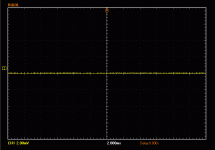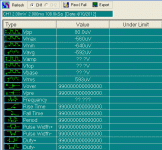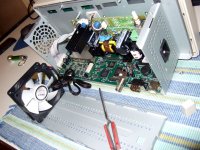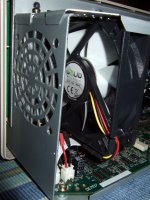Hello guys
I was looking around for a low end DSO the other day, Rigol DS1052E and the like. The various displays shown are striking me as ''noisy'' compared to my trusty 20MHZ analogue. OK, low BW brings less noise but I have used American, Japanese and European analogue ones with much more BW and still looked much smoother. I fancy the portability, small size, the auto measurements and configs and usb stick .bmp saves etc. But, hey, are those little computers any good for evaluating a PSU's or high gain circuit's total output noise roughly at all? I have seen Agilent's arguments and techniques (Hint#4 see link below) about working around that somehow (in much more expensive DSO Agilent example units that is). What is your experience in low end DSOs? Noisy as hell, or there are same ways around noise also with those? Results? Do they equal a classic analogue scope of medium BW after application of such tricks?
http://cp.literature.agilent.com/litweb/pdf/5989-7894EN.pdf
I was looking around for a low end DSO the other day, Rigol DS1052E and the like. The various displays shown are striking me as ''noisy'' compared to my trusty 20MHZ analogue. OK, low BW brings less noise but I have used American, Japanese and European analogue ones with much more BW and still looked much smoother. I fancy the portability, small size, the auto measurements and configs and usb stick .bmp saves etc. But, hey, are those little computers any good for evaluating a PSU's or high gain circuit's total output noise roughly at all? I have seen Agilent's arguments and techniques (Hint#4 see link below) about working around that somehow (in much more expensive DSO Agilent example units that is). What is your experience in low end DSOs? Noisy as hell, or there are same ways around noise also with those? Results? Do they equal a classic analogue scope of medium BW after application of such tricks?
http://cp.literature.agilent.com/litweb/pdf/5989-7894EN.pdf
Hi,
DSO's are great when you need math, FFT, memory, capturing single events, exporting waveforms, making eye-diagrams etc but, if youd need to check the smoothness of a sinewave, detect a minuscule crossover distortion or low level noise or oscillations, they are pretty worthless.
I use a Combiscope from Fluke, this gives the best of both worlds, but it stays approx. 95% of the time in analog mode.
DSO's are great when you need math, FFT, memory, capturing single events, exporting waveforms, making eye-diagrams etc but, if youd need to check the smoothness of a sinewave, detect a minuscule crossover distortion or low level noise or oscillations, they are pretty worthless.
I use a Combiscope from Fluke, this gives the best of both worlds, but it stays approx. 95% of the time in analog mode.
You need a good analog scope, like Tek 7603 with some vertical plug-ins e.g. 7A22, 7A13 (single channel differential amplifiers) for low and high frequency differential measurements and a dual time base 7B53A. The combination has affordable prices, for a well preserved machine. It is easily repairable and full of free documentation (service and operators manuals). And you can buy additional plug-in to cover your future needs. Then you need a cheep digital scope like Rigol. You can use one input of the Rigol, connected to the analog output of the Tek 7603 (it has the appropriate output BNC in rear panel). This way you can digitize your signal, with the better or more convenient front end of the old analog scope. The total cost (both analog and digital) will be less than 800 euro. After 10 years.... you can throw away the Rigol and.....go on with the Tek 7603 and a new cheep (maybe better) digital scope.
The other solution is to buy a relative expensive digital scope (Agilent. LeCroy, Tek). For the same features you must pay a lot of money and you must take in account the additional cost of differential probes and the any options you need (like software). The high performance scopes can have everything from both worlds, analog and digital but unfortunately in a high cost.
The other solution is to buy a relative expensive digital scope (Agilent. LeCroy, Tek). For the same features you must pay a lot of money and you must take in account the additional cost of differential probes and the any options you need (like software). The high performance scopes can have everything from both worlds, analog and digital but unfortunately in a high cost.
I recently bought a Chinese DSO with FFT to measure distortion from a power amp.
It shows about -60db at 1kHz, but I get about the same result from my signal source itself. I'm wondering if the problem is with my signal source or the DSO. I found this item on ebay, but hesitate to buy if the DSO is not up to the task. Any guidance much appreciated
Ultra low distortion (<0.00005%) 1kHz sine generator assembled and tested PCB | eBay
It shows about -60db at 1kHz, but I get about the same result from my signal source itself. I'm wondering if the problem is with my signal source or the DSO. I found this item on ebay, but hesitate to buy if the DSO is not up to the task. Any guidance much appreciated
Ultra low distortion (<0.00005%) 1kHz sine generator assembled and tested PCB | eBay
IMO, low end DSOs are useless for analog work and I can't afford the high end ones. For starters, 8 bit vertical resolution is completely inadequate for seeing noise or producing a useful FFT. They're nice for troubleshooting common problems and especially digital and control stuff, but I'd take a boat anchor analog scope for analog design any day.
Part of the problem with digital scopes IS the bandwidth. Most good scopes, such as the Teks, both the older analog and the more recent DSO's, have bandwidth limit switches. Setting the bandwidth to 20MHz can substantially reduce the noise shown on the trace for both analog and digital scopes.
Also, what exactly are you measuring? If it's a noise floor with no signal present, the limitation may be the scope's analog preamplifier, regardless of whether the scope is analog or digital. You might make a 20dB preamp with a low noise opamp to go between what you're measuring and the oscilloscope.
If you want to measure the noise floor with a signal present, I don't see where either an analog or digital scope would work (unless you make a high rejection notch filter for a single sine wave signal). A better option would be an audio interface for a computer. An oscilloscope is still a good idea for checking for RF oscillations in the MHz or higher range, frequencies beyond what the audio interface picks up.
Also, what exactly are you measuring? If it's a noise floor with no signal present, the limitation may be the scope's analog preamplifier, regardless of whether the scope is analog or digital. You might make a 20dB preamp with a low noise opamp to go between what you're measuring and the oscilloscope.
If you want to measure the noise floor with a signal present, I don't see where either an analog or digital scope would work (unless you make a high rejection notch filter for a single sine wave signal). A better option would be an audio interface for a computer. An oscilloscope is still a good idea for checking for RF oscillations in the MHz or higher range, frequencies beyond what the audio interface picks up.
How many bits resolution does it have? Most DSO's only do 8 bits, giving a theoretical (without dither) 48dB dynamic range.I recently bought a Chinese DSO with FFT to measure distortion from a power amp.
It shows about -60db at 1kHz,
Knowing more about your model of DSO might help, butbut I get about the same result from my signal source itself. I'm wondering if the problem is with my signal source or the DSO. I found this item on ebay, but hesitate to buy if the DSO is not up to the task. Any guidance much appreciated
Ultra low distortion (<0.00005%) 1kHz sine generator assembled and tested PCB | eBay
Take comfort that the Detroit Symphony Orchestra surely has much greater resolution than the other DSO's being discussed in this thread.Oh my, I feel silly. Around here, DSO means Detroit Symphony Orchestra. Imagine my confusion.
Part of the problem with digital scopes IS the bandwidth. Most good scopes, such as the Teks, both the older analog and the more recent DSO's, have bandwidth limit switches. Setting the bandwidth to 20MHz can substantially reduce the noise shown on the trace for both analog and digital scopes.
Hello zombie thread.
Got one 1052E in last year's summer anyway, and this on the pics is what it can show with probe X1 BW20MHz and 32X averaging. BW limit at 20MHZ does little compared to averaging, its only a (hacked) 100MHZ DSO. At X10 probe setting, hopeless at 4mV RMS trace noise with all the above aids. Otherwise it has good construction and parts, is very portable, used to be Agilent's OEM 1000 series. The screen is low analysis which I can't do anything about it, looks like a Sinclair ZX Spectrum video game, the other thing is its fan's annoying noise level, which I did something about. Very handy for many things due to modern automation and measuring, looks better screen wise if fed to the PC, I kept my old German CRT scope anyway.
Attachments
Oh my, I feel silly. Around here, DSO means Detroit Symphony Orchestra. Imagine my confusion.
Take comfort that the Detroit Symphony Orchestra surely has much greater resolution than the other DSO's being discussed in this thread.
Enzo: uis funny. Next time we are in Motown we make sure we will get tickets. They better be good! E
It seems that DIYaudio needs a new forum: /lamejokes
This is from another forum and is related to this topic although it speaks to the FFT spectrum analyzer function available on most DSOs. It is my response to a member who asked "In your experience, is it unrealistic to expect to be able to calculate a THD of around these kind of figures of 0.001% etc using the [insert name of a DSO here]?"
My response:
It is an unrealistic expectation for the [XYZ-100], and in fact for most digital 'scopes--here's why.
To observe 0.001% distortion accurately would require the displayed amplitude of the highest harmonic to be at least 100 db below that of the primary frequency. However as most DSOs use 8-bit analog-to-digital converters (ADCs) their best case, theoretical, dynamic range is 48 dB, I.e. a measurement/noise floor of -48 dB.
Good news however is that when using the FFT function there is a noise floor improvement (NFI), that is a factor of the frequency resolution (FR) of the capture data, per this formula:
Noise Floor Improvement (dB) = 10 * log10(FR) * k
where
This is what pushed your originally observed noise floor down to -60 dB.
In your original post the frequency resolution appeared to be 20 Hz or so, plugging that into the above formula and using a k of 1.0 we get:
NFI = 10 * log10(30) * 1.0 = 13.0 dB, making the total dynamic range 48.0 + 13.0 = 61.0 dB; making a positive harmonic amplitude observation limit of -55 dB, or 0.18 % at best.
Moving to a 12-bit scope would improve the dynamic range to 72.2 dB, however the NFI would remain the same for an FFT total dynamic range of 87 dB, still not enough for observing those -100 dB harmonics.
A 16-bit scope would do it. With a 96.3 dB base it's FFT could muster a 111.0 db range and the 0.001% harmonics would be distinctly visible with appropriate window selection and averaging.
As stated above, most DSOs are 8-bit which actually provides a display with characteristics very similar to an analog scope's CRT. However with a CRT based analog scope the random noise excursions are infrequently and quickly "hit", therefore they are more dimly displayed, if at all, which masks the noise.
Most higher-end DSOs have "digital phosphor" displays which behave like a CRT in this regard, however less expensive units do not and show all components of a signal, including infrequent random noise, at the same intensity.
The worst offenders are those inexpensive toy DSOs (or the grossly overpriced Tek TDS 2000 series 'scopes) with the "QVGA" 320x240 displays that do not have enough pixels to display the signal properly anyway:
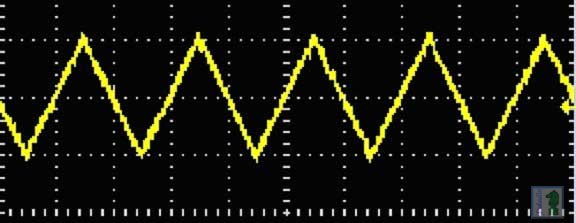
Here is a similar waveform, displayed on a DSO with a 640x480 display:
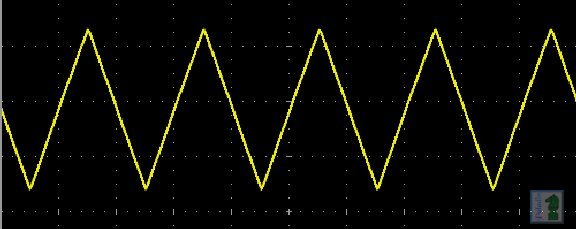
And, one more time on an 18-year old CRT based DSO with a 4096x4096 vector graphic display:
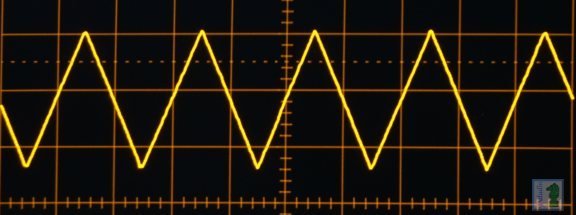
My response:
It is an unrealistic expectation for the [XYZ-100], and in fact for most digital 'scopes--here's why.
To observe 0.001% distortion accurately would require the displayed amplitude of the highest harmonic to be at least 100 db below that of the primary frequency. However as most DSOs use 8-bit analog-to-digital converters (ADCs) their best case, theoretical, dynamic range is 48 dB, I.e. a measurement/noise floor of -48 dB.
Good news however is that when using the FFT function there is a noise floor improvement (NFI), that is a factor of the frequency resolution (FR) of the capture data, per this formula:
Noise Floor Improvement (dB) = 10 * log10(FR) * k
where
- FR is the reciprocal of the waveform capture time;
k is a factor (1 to as much as 3) dependent on the chosen windowing function;
This is what pushed your originally observed noise floor down to -60 dB.
In your original post the frequency resolution appeared to be 20 Hz or so, plugging that into the above formula and using a k of 1.0 we get:
NFI = 10 * log10(30) * 1.0 = 13.0 dB, making the total dynamic range 48.0 + 13.0 = 61.0 dB; making a positive harmonic amplitude observation limit of -55 dB, or 0.18 % at best.
Moving to a 12-bit scope would improve the dynamic range to 72.2 dB, however the NFI would remain the same for an FFT total dynamic range of 87 dB, still not enough for observing those -100 dB harmonics.
A 16-bit scope would do it. With a 96.3 dB base it's FFT could muster a 111.0 db range and the 0.001% harmonics would be distinctly visible with appropriate window selection and averaging.
As stated above, most DSOs are 8-bit which actually provides a display with characteristics very similar to an analog scope's CRT. However with a CRT based analog scope the random noise excursions are infrequently and quickly "hit", therefore they are more dimly displayed, if at all, which masks the noise.
Most higher-end DSOs have "digital phosphor" displays which behave like a CRT in this regard, however less expensive units do not and show all components of a signal, including infrequent random noise, at the same intensity.
The worst offenders are those inexpensive toy DSOs (or the grossly overpriced Tek TDS 2000 series 'scopes) with the "QVGA" 320x240 displays that do not have enough pixels to display the signal properly anyway:

Here is a similar waveform, displayed on a DSO with a 640x480 display:

And, one more time on an 18-year old CRT based DSO with a 4096x4096 vector graphic display:

I was just reviewing my previous post, and realised that when cutting down its bulk I cut and pasted from different segments of the original making the numbers incorrect, a 1.8 dB error crept in--here is how it should read:
=============================================
NFI = 10 * log10(20) * 1.0 = 13.0 dB, making the total dynamic range 48.0 + 13.0 = 61.0 dB; making a positive harmonic amplitude observation limit of -55 dB, or 0.18 % at best.
Moving to a 12-bit scope would improve the dynamic range to 72.2 dB, however the NFI would remain the same for an FFT total dynamic range of 85.2 dB, still not enough for observing those -100 dB harmonics.
A 16-bit scope would do it. With a 96.3 dB base it's FFT could muster a 109.3 db range and the 0.001% harmonics would be distinctly visible with appropriate window selection and averaging.
=============================================
=============================================
NFI = 10 * log10(20) * 1.0 = 13.0 dB, making the total dynamic range 48.0 + 13.0 = 61.0 dB; making a positive harmonic amplitude observation limit of -55 dB, or 0.18 % at best.
Moving to a 12-bit scope would improve the dynamic range to 72.2 dB, however the NFI would remain the same for an FFT total dynamic range of 85.2 dB, still not enough for observing those -100 dB harmonics.
A 16-bit scope would do it. With a 96.3 dB base it's FFT could muster a 109.3 db range and the 0.001% harmonics would be distinctly visible with appropriate window selection and averaging.
=============================================
- Status
- This old topic is closed. If you want to reopen this topic, contact a moderator using the "Report Post" button.
- Home
- Design & Build
- Equipment & Tools
- DSO useless or not for measuring low noise?
